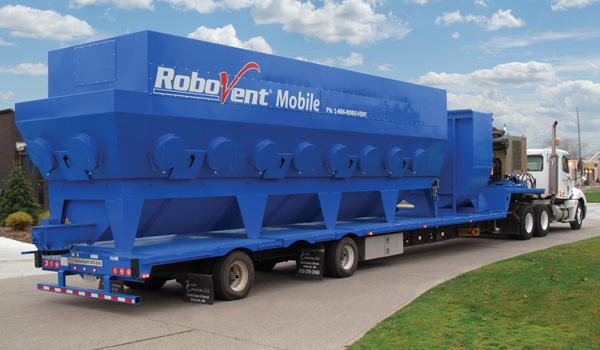Big Savings with RoboVent Mobile
February 2, 2011
Atsalis Brothers has been giving America a fresh coat of paint for almost sixty years. But not in safe and easy-to-reach places. Atsalis specializes in painting structures that are difficult to get to, hard to manage, always exposed to the weather and frequently dangerous.
Atsalis paints bridges and viaducts, often clogged with traffic and spanning great rivers, in all sorts of weather. And they do so under a stopwatch that measures how long and how many lanes of traffic must be closed to complete the work. Exceed the contract amounts and it can cost the company dearly.
It was with this knowledge that John Reid, owner of RoboVent Product Group, Inc. of Detroit, Michigan, and Jerry Douglas, the firm’s design engineer, approached the Clinton Township, Michigan painting contractor. RoboVent is a leader in designing and building a full range of air filtration systems, and it seemed likely that, since Atsalis offers sandblasting among its many services, the company might have a similar filtration and collection need.
“When they walked in the door, the first thing they asked was, ‘How can we help?’” said Nick Atsalakis, one of the owners of Atsalis. Nick didn’t have to struggle for an answer. Atsalis personnel are lifted to their work aboard a specially designed and patented mobile work platform that is positioned directly beneath the bridge to be painted. Aboard the trailer is a platform that can be raised to position the workers at exactly the right height for their tasks. Attached to the platform are side rails that extend 36-inches above the base. Once the platform is raised into place, company carpenters affix plywood sheeting to the side rails to form a safe and secure elevated work room that protects company personnel, passing drivers and pedestrians alike.
Atsalis already employed an air filtration system that worked in conjunction with their blasting operations to ventilate the work space, but the unit was mounted on a separate truck and required a second tractor and driver to get it to the work site. Could RoboVent design an air filtration system that would fit aboard the mobile work platform, travel with it to jobs and erect and retract right along with the platform? They could, and they have, with some exciting benefits to their customer.
Once back at his desk, Douglas sorted through the requirements for the job. “I knew what the Mobile Dust Collector needed to be effective; I just didn’t know if it could all be fitted in the space available.” The unit would require a 30 to 60-horsepower diesel engine, 15,000 cfm fan, intake, air filtration system, augur and hopper, all nestled aboard the 80-foot trailer and work platform. Some otherwise available space was already in use as a storage area for painting and sandblasting equipment and materials.
Then, too, the platform, which can be lifted to a height of 25 feet by large hydraulic cylinders, had to retract so that the overall height of the trailer did not exceed 10 feet to permit its transport on public highways. Any system that Douglas would design had to fit beneath the platform once it was lowered into its travel configuration.
It was slow going, with a few false starts and a couple of “if onlys.” But when the design was finally complete and RoboVent had fabricated the system to the critical dimensions, the mobile air filtration and collection system fit snugly, but successfully, beneath the platform, even at its lowest point.
Large flexhoses connect the blower with the elevated work room. The hopper has enough capacity for two to three days worth of dirt, dust and lead before needing to be emptied by the auger into 55-gallon drums. But the true test of the system’s value was yet to come.
“RoboVent’s design completely eliminated the cost of an additional tractor and driver, making our bids even more competitive,” said Mr. Atsalakis. “But the big differentiator with the new system is the need to close only one lane of traffic to accommodate the trailer and platform, in place of the two lanes that the side-by-side trailers required previously. Now more than ever, Atsalis is the team to beat in construction painting.”
But RoboVent innovation didn’t stop there. It next addressed the matter of providing air filtration and collection to Atsalis workers suspended above a river where land-based work platforms were excluded. The solution was to place the system on a barge, together with the company’s sandblasting and painting systems, and moor it adjacent to the section of bridge being painted.
To accomplish this, Douglas employed a 300-horsepower John Deere diesel driving a ten foot tall blower mounted atop a 48-foot flatbed trailer. The system produces an astonishing 100,000 cfm and collects dust and debris through 20-foot flexhoses that extend upward to the bottom of the bridge.
Atsalis has found a willing and effective partner in RoboVent, who is providing them with faster set-up time on the job-site, reduced employee and transportation costs, and a fifty percent reduction in lane closings. Together, RoboVent, the leader in clean air, is keeping Atsalis the leading painting contractor in the USA.
